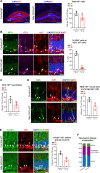Loss of NFIA Impairs Adult Hippocampal Neurogenesis
- PMID: 40459218
- PMCID: PMC12131691
- DOI: 10.1002/hipo.70016
Loss of NFIA Impairs Adult Hippocampal Neurogenesis
Abstract
Adult hippocampal neurogenesis (AHN) is the process by which new neurons are continuously generated from neural stem and progenitor cells (NSPCs) in the adult dentate gyrus. AHN plays a pivotal role in cognitive functions, including learning, memory, and mood regulation. Transcription factors regulate AHN by maintaining the NSPC pool and facilitating lineage progression. The nuclear factor I (NFI) transcription factor family member NFIA is critical for neurogenesis and gliogenesis during early brain development, but its role in adult neurogenesis remains poorly understood. Here, we generated an inducible Nfia loss-of-function mouse model to investigate the role of NFIA in Ascl1-lineage adult-born neurons. By tracking lineage progression from NSPCs to mature neurons, we found that NFIA deletion significantly reduced neurogenesis. Populations of NSPCs, neuroblasts, and mature granule neurons were all similarly diminished, indicating a primary defect in NSPC maintenance. Behaviorally, NFIA loss impaired hippocampal-dependent contextual fear memory without affecting locomotor activity, anxiety levels, spatial memory, or cued fear memory. Our findings demonstrate that NFIA is crucial for AHN and hippocampus-dependent contextual memory, thereby providing insights into its role in adult neurogenesis.
Keywords: NFIA; adult hippocampal neurogenesis; dentate gyrus; hippocampus; learning and memory.
© 2025 The Author(s). Hippocampus published by Wiley Periodicals LLC.
Conflict of interest statement
The authors declare no conflicts of interest.
Figures


References
MeSH terms
Substances
Grants and funding
LinkOut - more resources
Full Text Sources
Molecular Biology Databases

